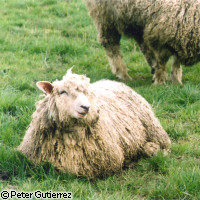Study finds solution to sheep dip toxicity
A University College Dublin study has found that sheep dips, which are toxic to fish and bees, can be broken down by bacteria. This finding could lead to vast improvements in the disposal of sheep-dip waste, which would significantly benefit water systems near sheep farms. Sheep dips are used by shepherds to protect sheep from infestation by insects and fungi, for example, mites, blow-flies, ticks, keds and lice. By helping to control skin parasites, dipping prevents suffering and ill health in sheep. Commonly used dips come in a wettable powdered form and are made from pyrethrins, synthetic compounds originally derived from east African chrysanthemum flowers. Pyrethrins are highly toxic to insects and very highly toxic to fish. When used in combination with piperonyl butoxide, they paralyse and kill harmful and beneficial insects alike, including bees and dragonflies; this causes problems for pollination. According to Dr Mairin Cannon, coordinator of the study, a very small amount of pyrethrin 'can wipe out all the fish in an entire river'. The dangers posed by pyrethrins are similar to those posed by many ground water pollutants: once absorbed by smaller organisms they can move up the food chain, increasing their toxic potential along the way. Pyrethrins are popular because they are effective at killing harmful pests but break down easily when exposed to air and sunlight for a day or two. This makes them relatively nontoxic to humans, other mammals and birds and they are therefore used in a wide variety of home and garden products (mosquito spray, head lice shampoo, ant powders, fly sprays, etc.). However, there are some indications that exposure to pyrethrins can be a cancer risk for humans, especially in cases of prolonged contact with treated indoor surfaces and insecticide 'fogs'. Sheep are normally dipped around two times a year, and after dipping they stand, dripping, for about 10 minutes before being transported back to their fields. In the fields, heavy rainfall can cause used sheep dip to leach out into watercourses; additionally, sheep are sometimes transported through streams, where the dip can also find its way into the water despite the farmers having followed good agricultural practice. When pyrethrins enter the groundwater they are, of course, no longer exposed to air and sunlight and cannot be broken down easily. A safe, sustainable and easily deployable solution to this problem has been sought for some time. The current findings have significant implications for farming and groundwater quality. The researchers have identified eight different bacteria originating in sheep-dip-contaminated soil which, in higher concentrations, can break down the pyrethroid compounds. The study examined 30 different bacteria gathered from sheep-dip-polluted soil and dipping tanks, testing to see whether they could degrade the pyrethroids before the sheep dip was diluted. Seventy-five percent of the compound was degraded by one of these bacteria, a finding that Dr Cannon calls 'unprecedented'. The bacteria could potentially be added into sheep-dip tanks before the waste water is thrown out, significantly reducing the polluting potential of the waste water. Dr Cannon commented: 'This could prevent a cascade of detrimental effects to fish, bees, aquatic invertebrates and ultimately humans.' The study was presented today at the Society for General Microbiology's autumn meeting held at Trinity College, Dublin, Ireland.
Countries
Ireland



